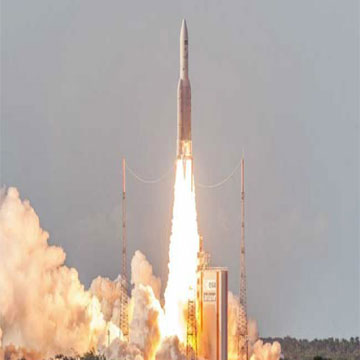GSAT-18, ISRO's latest communication satellite, launched successfully
By FnF Correspondent | PUBLISHED: 06, Oct 2016, 13:41 pm IST | UPDATED: 06, Oct 2016, 18:37 pm IST
 Bangalore:
Bangalore: Marking another success for the space agency, ISRO’s latest communication satellite GSAT-18 has successfully been launched from Arianespace’s European launcher Ariane-5 VA-231 in French Guiana. GSAT-18 is the 20th satellite from ISRO to be launched by the European space agency and this mission was the 280th for Arianespace launcher family. Given that ISRO has been dependent on Ariane-5 rocket for carrying its heavier satellites, the space agency is now developing GSLV Mk III for this purpose.
The main aim of GSAT-18 is to provide telecommunications services. It would strengthen ISRO’s present fleet of 14 operational telecom satellites. GSAT-18’s mission life is around 15 years, and carries Ku-band beacon to help in accurately pointing ground antennas towards the satellite. “GSAT 18 is an important satellite for us that will enable the continuity of the vital communication services in our country by replacing the currently ageing satellites,” the ISRO chief said. Television, telecommunication, VSAT and digital satellite news gathering were a few of the services that GSAT 18 will support in coming days, he added.
The 3,404 kg GSAT-18 carries 48 communication transponders in C-band, upper extended C-band and Ku-band for providing various services to the country, says ISRO. The GSAT-18 was launched into a Geosynchronous Transfer Orbit (GTO) about 32 minutes after the lift-off. ISRO’s Master Control Facility (MCF) at Hassan in Karnataka took over the command and control of GSAT-18 immediately after its separation from the launch vehicle. According to preliminary health checksc conducted by ISRO, the satellite is in ‘normal health’. In the coming days, ISRO will perform the orbit raising manoeuvres to place the GSAT-18 in the Geostationary Orbit (36,000 km above the equator).
After that two solar arrays and both the antenna reflectors of GSAT-18 will be deployed. Lastly, the satellite will be put in its final orbital configuration. There are subsequent plans to experimentally turn on the communication payloads of GSAT-18. After the successful completion of all the in-orbit tests, GSAT-18 will be ready for operational use, says ISRO.
 Bangalore: Marking another success for the space agency, ISRO’s latest communication satellite GSAT-18 has successfully been launched from Arianespace’s European launcher Ariane-5 VA-231 in French Guiana. GSAT-18 is the 20th satellite from ISRO to be launched by the European space agency and this mission was the 280th for Arianespace launcher family. Given that ISRO has been dependent on Ariane-5 rocket for carrying its heavier satellites, the space agency is now developing GSLV Mk III for this purpose.
Bangalore: Marking another success for the space agency, ISRO’s latest communication satellite GSAT-18 has successfully been launched from Arianespace’s European launcher Ariane-5 VA-231 in French Guiana. GSAT-18 is the 20th satellite from ISRO to be launched by the European space agency and this mission was the 280th for Arianespace launcher family. Given that ISRO has been dependent on Ariane-5 rocket for carrying its heavier satellites, the space agency is now developing GSLV Mk III for this purpose.